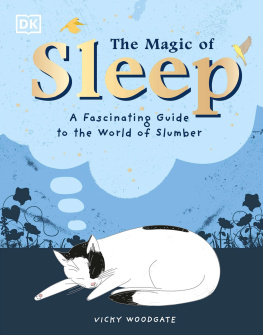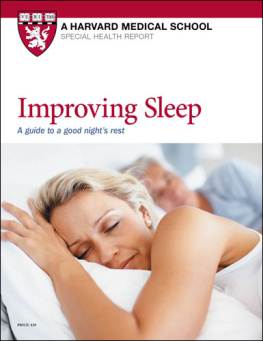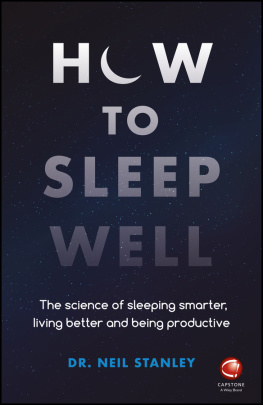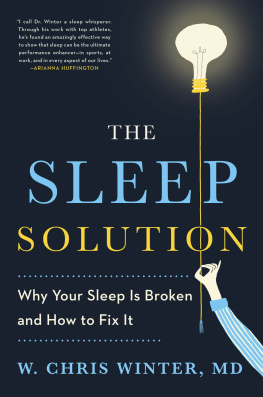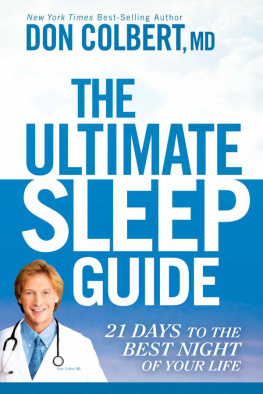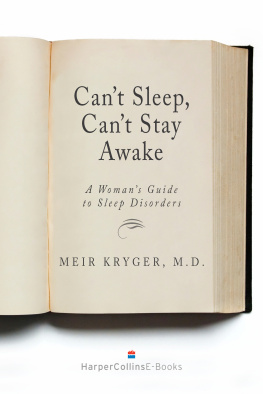The Mystery of Sleep
The Mystery of Sleep
Why a Good Nights Rest Is Vital to a Better, Healthier Life

MEIR KRYGER, M.D.
Yale
UNIVERSITY PRESS
New Haven and London
The information and suggestions contained in this book are not intended to replace the services of your physician or caregiver. Because each person and each medical situation is unique, you should consult your own physician to get answers to your personal questions, to evaluate any symptoms you may have, or to receive suggestions for appropriate medications.
The author has attempted to make this book as accurate and up-to-date as possible, but it may nevertheless contain errors, omissions, or material that is out of date at the time you read it. Neither the author nor the publisher has any legal responsibility or liability for errors, omissions, out-of-date material, or the readers application of the medical information or advice contained in this book.
Published with assistance from the foundation established in memory of Amasa Stone Mather of the Class of 1907, Yale College.
Copyright 2017 by Meir Kryger, M.D.
All rights reserved.
This book may not be reproduced, in whole or in part, including illustrations, in any form (beyond that copying permitted by Sections 107 and 108 of the U.S. Copyright Law and except by reviewers for the public press), without written permission from the publishers.
Yale University Press books may be purchased in quantity for educational, business, or promotional use. For information, please e-mail (U.K. office).
Designed by Sonia L. Shannon.
Set in Electra type by Integrated Publishing Solutions.
Printed in the United States of America.
Library of Congress Control Number: 2016952688
ISBN 978-0-300-22408-5 (hardcover : alk. paper)
A catalogue record for this book is available from the British Library.
This paper meets the requirements of ANSI/NISO Z39.481992 (Permanence of Paper).
10 9 8 7 6 5 4 3 2 1
This book is dedicated to my wife, Barbara, and my children,
Shelley and Jason, Michael and Emily, and Steven

Sleep that knits up the ravelld sleave of care, The death of each days life, sore labours bath, Balm of hurt minds, great natures second course, Chief nourisher in lifes feast.
SHAKESPEARE, MACBETH (2.2.4851)
Contents
Preface
SLEEP HAS ALWAYS BEEN a mystery to me. Almost two decades ago, a woman with narcolepsy and I were interviewed on a live radio program about the impact of sleep disorders on daily life. A couple of hours later, when I was back in my office, I received a phone call from a literary agent, who asked me how sleep disorders affected women. As we chatted, it became obvious that the general public did not appreciate that women suffer from many sleep problems that men do not, and that because of the variety of roles they play in society, sleep disorders affect women differently from the way they do men. I had written or edited several books about sleep for doctors. It was time for a book for women; this was born in 2004. Now, in this new book, I explore the impact of sleep disorders on the entire family and society.
Although sleep disorders are common and there has been an upsurge of interest in them in the past few years, millions of people still suffer from the effects of undiagnosed sleep problems. The National Sleep Foundation estimates that up to 47 million American adults may be putting themselves at risk for injury and health and behavior problems because they are not getting enough sleep. The National Institutes of Health estimates that between 50 and 70 million Americans of all ages have sleep-related problems, including insomnia and sleep apnea.
In the mid-1970s, when I reported one of the first cases in North America of what eventually became known as sleep apnea, I thought I was describing a rare condition. In the next two decades it became apparent that sleep apnea was as common as asthma, and it affects millions of people worldwide. The condition was not new, but people who had it were being misdiagnosed and treated for the wrong conditions. Sleep apnea and other sleep-breathing disorders were seen as problems of overweight men who snore and were thought to be rare or even nonexistent in women. Until 1993 few doctors even looked for sleep apnea among women in the general population. It has since become clear that at least 2 percent of all adult women have sleep apnea. Just as men who had sleep apnea went undiagnosed for many years, until recently women with sleep apnea were misdiagnosed and often treated for other conditions such as depression.
More attention must be given to sleep disorders, which can cause misery and even death. Treatment is often delayed because a patients sleep problems are not recognized. People with narcolepsy, for instance, on average wait fifteen years for a correct diagnosis often after consulting many doctors. Yet this incurable condition has serious consequences. How can a person who cannot stay awake take care of children or have a career? One of my patients was referred to me only after she had fallen asleep while driving and crashed. Her two-year-old daughter was killed.
Sleep apnea has also been linked to heart disease. People with sleep apnea repeatedly stop breathing, which reduces blood oxygen, causing high blood pressure and stressing the cardiovascular system, potentially leading to heart disease or stroke, and possibly hastening cognitive decline in the elderly. Most people do not appreciate how deadly certain sleep disorders can be, but it is vitally important that sufferers of sleep disorders get a correct diagnosis and the proper treatment.
Over the past forty years, I have treated more than thirty thousand patients with sleep problems and have seen firsthand the disastrous consequences of years of misdiagnosis and lack of treatment. I wrote this book to help raise awareness of the effects of sleep disorders on peoples daily (and nightly) lives. Sleep problems can occur at any stage of life. This book is intended to provide the tools people need to recognize and understand their own sleep disorders and those of family members and to help them find treatment. My goal is to educate and empower people, to enable them to stay awake and alert so they can enjoy life to the fullest.
Acknowledgments
A SPECIAL THANKS TO Dr. Norah Vincent, a colleague and clinical psychologist, who provided the content on the behavioral treatment of insomnia. Swen Salgadoe, a former Northwest flight attendant whom I am proud to call my niece, is an expert in overcoming jet lag and supplied an insiders view on how to do it.
Thank you to Jean Thomson Black, Mary Pasti, Samantha Ostrowski, Susan Laity, and the staff of Yale University Press for help and encouragement in all the steps in the production of this work.
Thank you as well to my patients, who taught me how sleep disorders affected their lives.
Finally a huge hug, kiss, and so forth to my wife, Barbara, who reviewed and edited the text and often put up with my laptop on the corner of the kitchen table while I was writing this.
PART ONE

A Good Nights Sleep
1
Why Do We Sleep?

Next page

